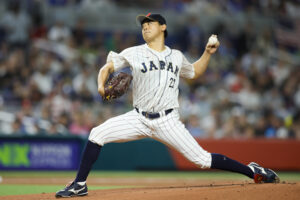The Cubs officially announced the signing of left-hander Shota Imanaga to a four-year contract. It’s reportedly a $53MM guarantee. The deal contains a fifth-year team option and could reach $80MM. The Cubs will need to decide after the 2025 and potentially ’26 seasons whether to exercise the option for 2028. If the club declines the option at either point, Imanaga would have the ability to opt out and become a free agent. He receives limited no-trade rights and would earn a full no-trade clause if the Cubs exercise either of their options.
On top of what they’ll pay Imanaga, the Cubs owe a posting fee to the Yokohama BayStars of Nippon Professional Baseball. That’ll initially be a $9.825MM sum and would increase if the team exercises the option and/or Imanaga unlocks more money via escalators. The Cubs would owe the BayStars an additional 15% of whatever money the southpaw earns beyond the initial guarantee.
It’s the first MLB free agent pickup of the offseason for the Cubs. It’s a big acquisition, as the southpaw is one of the more intriguing pitchers in this year’s class. That makes the financial terms unexpected. At the beginning of the offseason, MLBTR predicted a five-year, $85MM contract. Reporting in recent weeks had suggested he could top $100MM. Even with the conditional opt-out possibilities, a $53MM guarantee and an $80MM maximum value comes in below general expectations.
Imanaga has spent the past eight seasons with the BayStars in his home country. He owns a career 3.18 ERA in a league generally regarded as the second-best level in the world. Imanaga has turned in a 3.08 or better in each of the past three seasons, including a sub-3.00 figure for the last two years.
During the 2023 campaign, he allowed 2.80 earned runs per nine through 148 innings. He led all NPB hurlers with 174 strikeouts, narrowly topping Dodgers’ $325MM signee Yoshinobu Yamamoto in that regard. That’s an impressive 29.2% clip that’s well above the 22.1% MLB average. He paired that with a tidy 4% walk rate, ranking him among NPB’s best pitchers at dominating the strike zone.

Despite the strong strikeout and walk profile, Imanaga doesn’t come with the kind of excitement generated by Yamamoto. That’s in part due to age. Having turned 30 last September, Imanaga is a typical age for a first-time free agent starter. More importantly, his repertoire points more toward a projection as a solid mid-rotation arm than a potential ace.
Evaluators with whom MLBTR spoke before the offseason suggested Imanaga profiles as a #3/4 pitcher in a big league rotation. Baseball America’s Kyle Glaser pegged him as a #4/5 type in a scouting report from early December. The 5’10” hurler typically sits in the low-90s with his fastball, touching the 94-95 MPH range in shorter stints.
Evaluators have credited him with above-average life on the pitch, allowing it to play for whiffs at the top of the strike zone despite the pedestrian velocity. Glaser writes that Imanaga backs that up with an above-average split but suggests his MLB upside may be capped by middling breaking stuff.
The main concern in Imanaga’s statistical profile has been the longball. He surrendered 17 homers last season, the second-most of any NPB pitcher. While some of that is attributable to workload — he was 15th in innings pitched — it hints at a fly-ball profile that could give some evaluators pause. The Yankees reportedly stayed on the periphery of the bidding in part because of concerns that Imanaga wouldn’t profile well in a very hitter-friendly home park. Statcast’s Park Factors rate Wrigley Field as slightly favorable to home runs, but it’s not among the top handful of hitting venues in MLB.
Imanaga’s stellar strikeout/walk profile and consistently strong results generated a decent amount of reported interest. The Red Sox, Giants and Angels were all reported to be in the bidding of late. He’ll bypass those teams to step into a Chicago rotation that seems likely to lose Marcus Stroman to free agency.
Imanaga joins Justin Steele, Kyle Hendricks and Jameson Taillon as locks for the Opening Day rotation. The likes of Jordan Wicks, Javier Assad, Hayden Wesneski and prospect Ben Brown could battle for the #5 job. There’s still plenty of time for president of baseball operations Jed Hoyer and his front office to add another starter if they want to solidify the final spot and push all their younger, unproven arms into depth roles.
The fee to the BayStars is proportional to the contract value: 20% of the deal’s first $25MM ($5MM), 17.5% of the next $25MM ($4.375MM) and 15% of further spending ($450K). The 15% rate also applies to whatever future earnings Imanaga secures.
A posting fee is on top of the sum to the player but not included in the deal’s competitive balance tax calculation. The average annual value checks in at $13.25MM. According to Roster Resource, that’ll push the team’s CBT number north of $198MM. That’s nowhere near next year’s $237MM tax threshold. Evenly distributing the salaries would move the team’s 2024 payroll commitments to roughly $191MM — slightly beyond last year’s approximate $184MM Opening Day mark.
Bob Nightengale of USA Today first reported the Cubs had an agreement with Imanaga. Jon Heyman of the New York Post reported the presence of various escalators and option provisions and the deal’s $80MM maximum value. ESPN’s Jesse Rogers reported the four-year, $53MM agreement, as well as the club option/opt-out possibilities after years two and three. Patrick Mooney of the Athletic reported the no-trade provisions.
Image courtesy of USA Today Sports.
